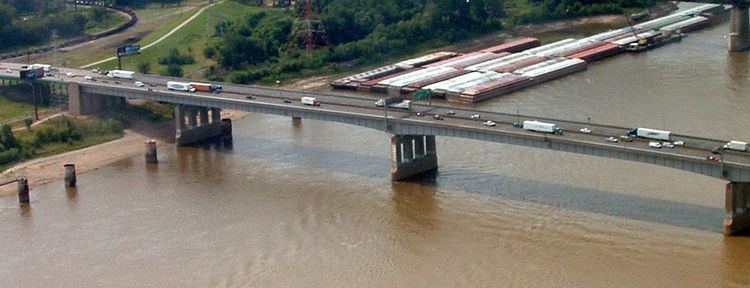Width 104 ft (32 m) Construction started 1959 Total length 660 m | Address St. Louis, MO 63102, USA Opened 9 November 1967 Location St. Louis, East St. Louis | |
 | ||
Carries 8 lanes of I‑55 / I‑64 / US 40 Official name Congressman William L. Clay Sr. Bridge Similar | ||
The Congressman William L. Clay Sr. Bridge, formerly known as the Bernard F. Dickmann Bridge and popularly as the Poplar Street Bridge or PSB, completed in 1967, is a 647-foot-long (197 m) deck girder bridge across the Mississippi River between St. Louis, Missouri, and East St. Louis, Illinois. The bridge arrives on the Missouri shore line just south of the Gateway Arch.
Planned just before construction of the Arch, the builders in 1959 were to request that 25 acres (10 ha) of the Gateway Arch property be turned over from the National Park Service for the bridge. The request generated enormous controversy and ultimately 2.5 acres (1.0 ha) of the Jefferson Expansion National Memorial (which included all of the original platted area of St. Louis when it was acquired in the 1930s and 1940s) was given to the bridge.
Two Interstates and a U.S. Highway cross the entire bridge. Approximately 100,000 vehicles daily cross the bridge daily, making it the second most heavily used bridge on the river, after the I-94 Dartmouth Bridge in Minneapolis, Minnesota. Some of that load has been diverted to the Stan Musial Veterans Memorial Bridge.
Interstate 55 (I-55), I-64 and U.S. Route 40 (US 40) cross the Mississippi on the Poplar Street Bridge. US 66 also ran concurrently over this bridge until 1979, and US 50 was routed over it before the Interstates were constructed. In addition, I-70 crossed the river here until 2014, when it was realigned to cross the river on the Stan Musial Veterans Memorial Bridge when it was completed. I-44 now follows the old alignment of I-70 through downtown to the west approach for the Stan Musial Veterans Memorial Bridge although motorists traveling east on I-44 must continue west on I-70 and do not have a direct connection to the bridge. The traffic was heavily congested until the opening of the new bridge in early February 2014. In 2012, 123,564 vehicles used it every day, but after the new bridge opened, congestion alleviated by almost 14%, less than the predicted 20% decline with 106,500 vehicles using it every day because total traffic across the river from all bridges increased by 7.4% over 2013 levels.
The east end of the bridge crosses the south end of what was Bloody Island which Robert E. Lee connected to the mainland of Illinois with landfill in the 1850s. During its island days several Missouri politicians fought duels there. What was Bloody Island is now a train yard.
Although the bridge's former name honors former St. Louis mayor Bernard F. Dickmann, it is most commonly referred to as the Poplar Street Bridge, with many locals unaware of its official name. The Missouri end of the bridge sits over Poplar Street, and the media started referring to it by that name long before the bridge opened. It was officially renamed as the Congressman William L. Clay Sr. Bridge in October 2013 in honor of Bill Clay.
